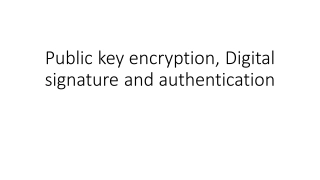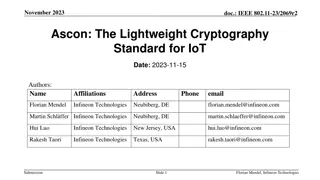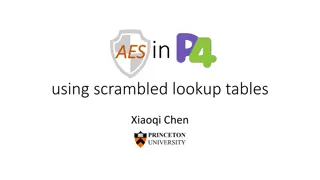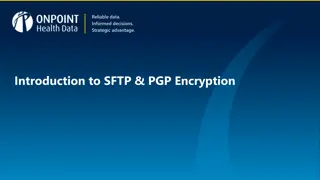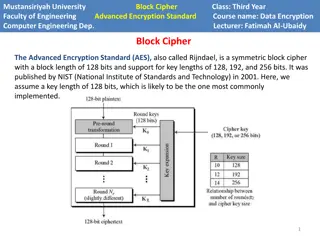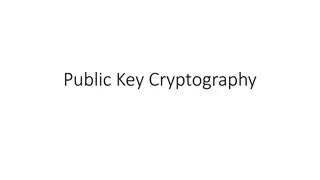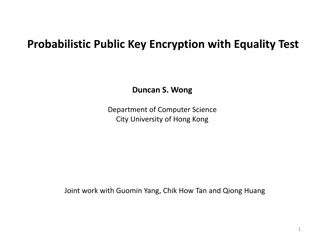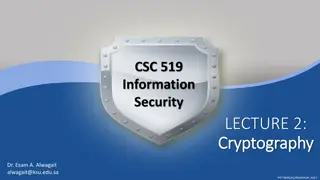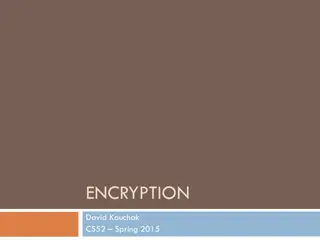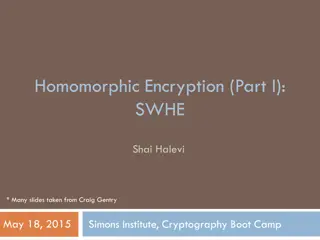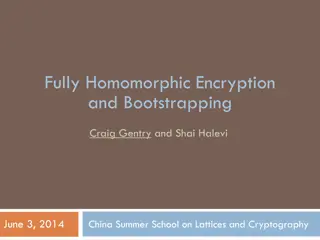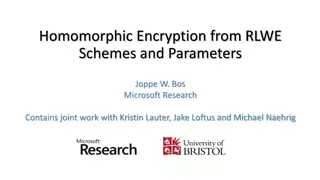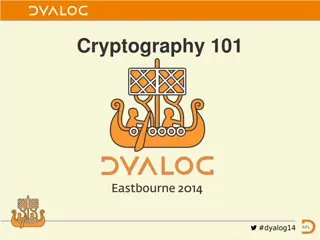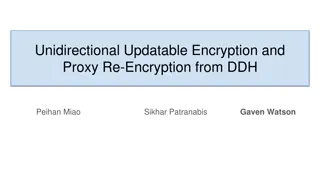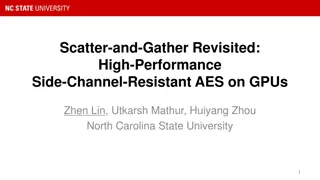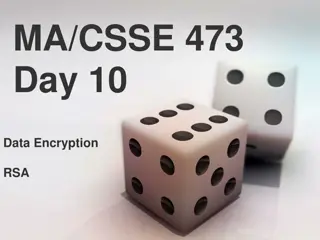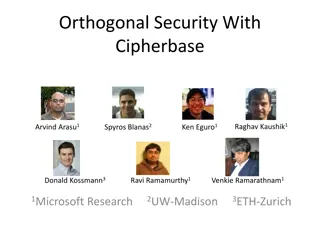Overview of SMX Algorithm and AES Encryption Standard
The SMX Algorithm presents a fresh approach to the avalanche effect in the Advanced Encryption Standard (AES). Initially developed to overcome the limitations of the Data Encryption Standard (DES), AES boasts improved security and efficiency, supporting key lengths of 128, 192, and 256 bits. The AES structure involves key stages like Substitute Bytes, Shift Rows, Mix Columns, and Add Round Keys, ensuring reversible encryption and decryption processes. Despite AES's strengths, challenges like the static S-Box with potential vulnerabilities have been identified. To address this, a proposed methodology for a dynamic S-Box system has been suggested, aiming to enhance encryption strength against attacks.
Download Presentation

Please find below an Image/Link to download the presentation.
The content on the website is provided AS IS for your information and personal use only. It may not be sold, licensed, or shared on other websites without obtaining consent from the author.If you encounter any issues during the download, it is possible that the publisher has removed the file from their server.
You are allowed to download the files provided on this website for personal or commercial use, subject to the condition that they are used lawfully. All files are the property of their respective owners.
The content on the website is provided AS IS for your information and personal use only. It may not be sold, licensed, or shared on other websites without obtaining consent from the author.
E N D
Presentation Transcript
SMX Algorithm: A Novel Approach to Avalanche Effect on Advanced Encryption Standard AES RESEARCH PRESENTATION SOHAIL SHAHUL HAMEED Dr. BHARGAVI GOSWAMI
AES AES DES Failed, trust broken, 3DES was a temporary solution. NIST in 1997 issues a call for proposals for a new Advanced Encryption Standard. Requirements: Security better or equal to 3DES, Improved efficiency. Mustbe a symetric block cipher with a block length of 128 bits and support for key lengths of 128, 192, and 256 bits. Evaluation criteria: include security, computational efficiency, memory requirements, hardware and software suitability, and flexibility. In first round, 15 proposals were accepted, out of which in 2nd round 5 algorithms were shortlisted and out of them Rijndeal was proposed as AES developed by cryptographers from Belgium, i.e Dr. Joan Daemen and Dr.Vincent Rijmen.
AES AES AES uses block length of 128bits and a key length that can be 128, 192 or 256 bits. 1. Substitute Bytes: Uses S-box to perform byte by byte substitution of block. 2. Shift Rows: Simple permutation row by row. 3. Mix columns: Substitution that alters each byte in column as a function of all of bytes in column. 4. Add Round Keys: Simple bitwise XOR of current block with a portion of expanded key. For both encryption and decryption, the cipher begins with an Add Round Key stage, followed by Nine rounds that each includes all four stages, Followed by a tenth round of three stages. Only the Add Round Key stage makes use of the key. For this reason, the cipher begins and ends with an Add Round Key stage. Advantage: Each stage is easily reversible.
AES STRUCTURE AES STRUCTURE
AES STRUCTURE AES STRUCTURE
AES STRUCTURE AES STRUCTURE
problem statement problem statement Use of static S-Box IN aes NO RANDOMNESS IN THE OUTPUT Prone to attacks
PROPOSED METHODOLOGY PROPOSED METHODOLOGY Dynamic S-Box : 16 byte KEY 4 5 6 8 9 11 13 14 15 3 0 1 2 7 10 12 Sum =KEY[0]+KEY[1]+ ..+KEY[15] Index=Sum %16 Dynamic Sbox=Static Sbox xor KEY[Index]
Encryption ALGORITHM OF Encryption ALGORITHM OF PROPOSED PROPOSED smx smx aes aes Chose a master key for AES. Compute sum of each round key and mod with 16 to get the index of the round key. for i= 1 to 10 sum[i]=RoundKey[0]+RoundKey[1]+........+RoundKey[15]. index=sum[i]%16. Compute New SMXS-Box, where each cell is equal to XOR with index of the key. New SMXSbox=InvSboxAES RoundKey[index]. Continue as described in the AES algorithm.
DECRYPTION ALGORITHM OF DECRYPTION ALGORITHM OF PROPOSED PROPOSED smx smx aes aes Chose a initial key for AES. Compute sum of each round key and mod with 16 to get the index of the round key. for i= 1 to 10 sum[i]=RoundKey[0]+RoundKey[1]+........+RoundKey[15]. index=sum[i]%16. Compute New SMXS-Box, where each cell is equal to XOR with index of the key. New SMXSbox=InvSboxAES RoundKey[index]. Computing inverse INV New SMXSbox = INV(InvSboxAES RoundKey[index]). Continue as described in the AES algorithm.
AVALANCHE EFFECT AVALANCHE EFFECT Avalanche effect, is the measure of the number of bits flipped in the ciphertext when one bit of the plaintext is changed. The measure of the output bits should be changed 50% with respect to the input bits. Avalanche effect = (number of flipped bits * 100 total number of bits)
AVALANCHE EFFECT of AVALANCHE EFFECT of normal normal aes aes
AVALANCHE EFFECT of AVALANCHE EFFECT of dynamic dynamic aes aes
AVALANCHE EFFECT of AVALANCHE EFFECT of proposed proposed smx smx aes aes
COMPARISON OF NORMAL AES, COMPARISON OF NORMAL AES, DYNAMIC AES, AND PROPOSED DYNAMIC AES, AND PROPOSED smx smx AES based on plaintext AES based on plaintext 20 % gain in comparison of dynamic AES and 35 % gain in comparison of normal AES.
COMPARISON OF DYNAMIC AES COMPARISON OF DYNAMIC AES AND PROPOSED AES based on AND PROPOSED AES based on plaintext plaintext The range of variations in dynamic AES is 17.19 where as in proposed SMX AES is 13.29, a gain of 3.9 points.
COMPARISON OF DYNAMIC AES COMPARISON OF DYNAMIC AES AND PROPOSED AES based on AND PROPOSED AES based on master key master key
Simulation time of all Simulation time of all three algorithms three algorithms Encryption time gain in SMX AES in comparison of dynamic AES is 0.00264615 seconds. Decryption time gain in SMX AES in comparison of dynamic AES is 0.000893 seconds. 0.02036 0.02062 0.02234 0.02122 0.01969 0.02033
conclusion conclusion SMX AES shows that there is 20% gain in comparison of dynamic AES and 35 % gain in comparison of normal AES. The range of variations in dynamic AES is 17.19 where as in proposed SMX AES is 13.29, a clear gain of 3.9 points in SMX AES. The most significant time gain test results show that encryption time gain in SMX AES in comparison of dynamic AES is 0.00264615 seconds. Similarly, decryption time gain in SMX AES in comparison of dynamic AES is 0.000893 seconds.


